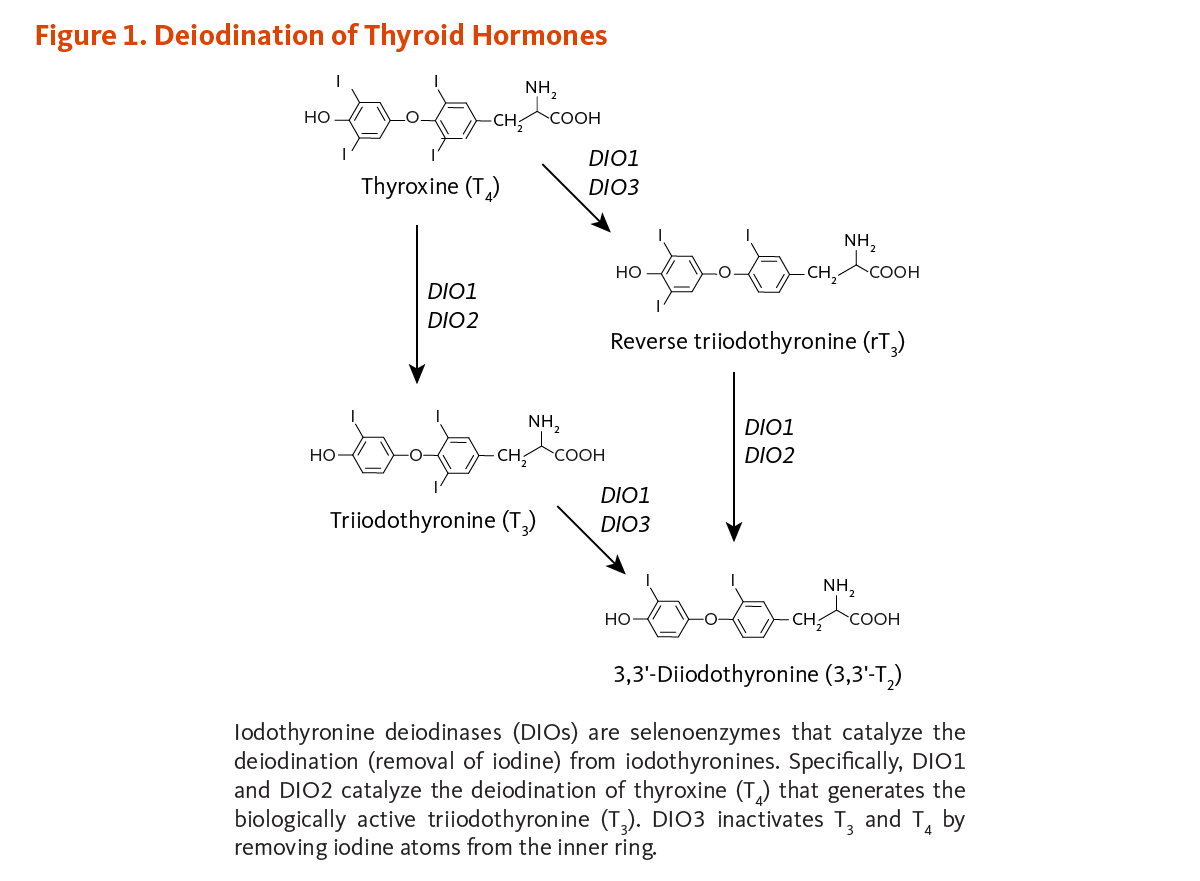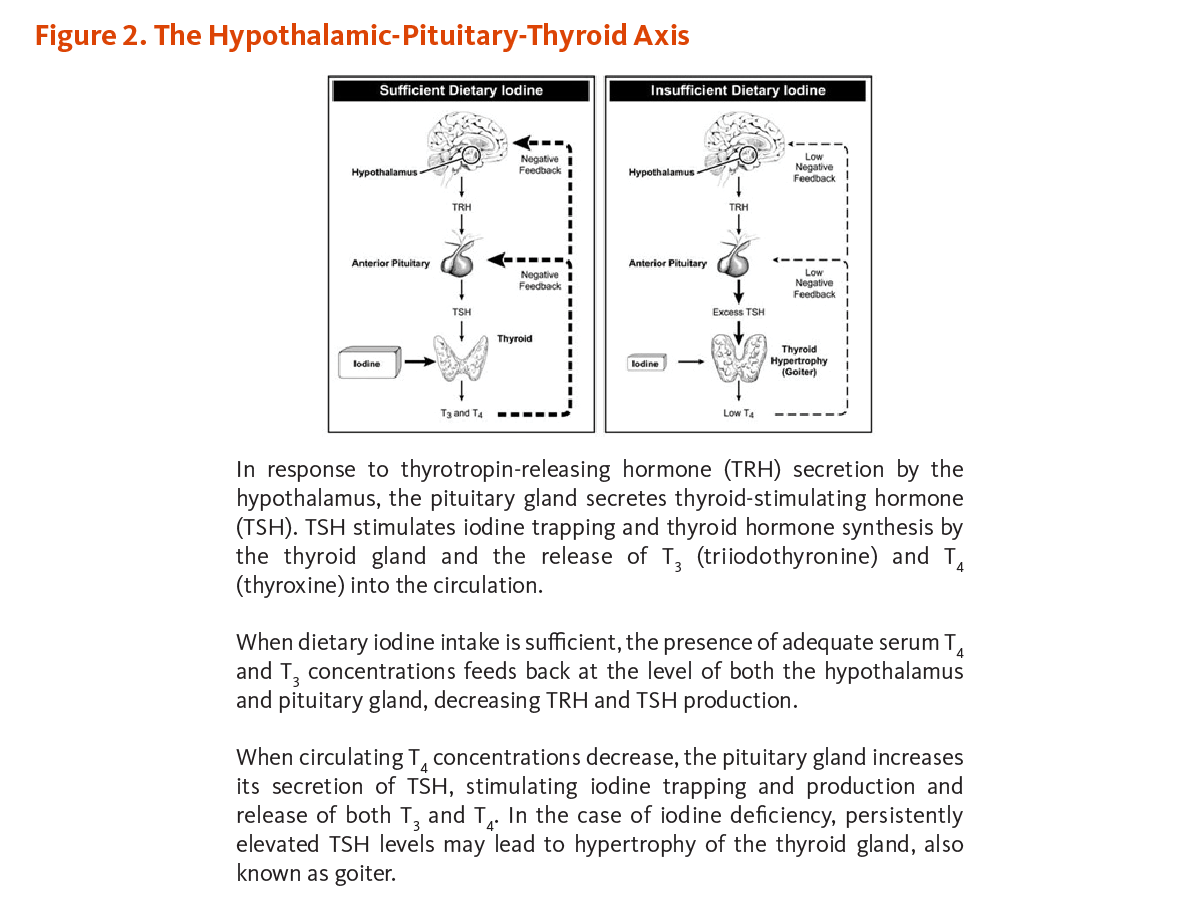Category
Iodine is a mineral found in some foods.
Main Function


What is the RDA of iodine?
Recommended Intakes
Intake recommendations for iodine and other nutrients are provided in the Dietary Reference Intakes (DRIs) developed by the Food and Nutrition Board (FNB) at the Institute of Medicine of the National Academies (formerly National Academy of Sciences) [2]. DRI is the general term for a set of reference values used for planning and assessing nutrient intakes of healthy people. These values, which vary by age and gender [2], include:
- Recommended Dietary Allowance (RDA): Average daily level of intake sufficient to meet the nutrient requirements of nearly all (97%–98%) healthy individuals; often used to plan nutritionally adequate diets for individuals.
- Adequate Intake (AI): Intake at this level is assumed to ensure nutritional adequacy; established when evidence is insufficient to develop an RDA.
- Estimated Average Requirement (EAR): Average daily level of intake estimated to meet the requirements of 50% of healthy individuals; usually used to assess the nutrient intakes of groups of people and to plan nutritionally adequate diets for them; can also be used to assess the nutrient intakes of individuals.
- Tolerable Upper Intake Level (UL): Maximum daily intake unlikely to cause adverse health effects.
Table 1 lists the current RDAs for iodine [2]. For infants from birth to 12 months, the FNB established an AI for iodine that is equivalent to the mean intake of iodine in healthy, breastfed infants in the United States.
| Age | Male | Female | Pregnancy | Lactation |
|---|---|---|---|---|
| Birth to 6 months | 110 mcg* | 110 mcg* | ||
| 7–12 months | 130 mcg* | 130 mcg* | ||
| 1–3 years | 90 mcg | 90 mcg | ||
| 4–8 years | 90 mcg | 90 mcg | ||
| 9–13 years | 120 mcg | 120 mcg | ||
| 14–18 years | 150 mcg | 150 mcg | 220 mcg | 290 mcg |
| 19+ years | 150 mcg | 150 mcg | 220 mcg | 290 mcg |
* Adequate Intake (AI)
The World Health Organization (WHO), United Nations Children’s Fund (UNICEF), and the International Council for the Control of Iodine Deficiency Disorders (ICCIDD) recommend a slightly higher iodine intake for pregnant women of 250 mcg per day [3,7].
Sources of Iodine
Seaweed (such as kelp, nori, kombu, and wakame) is one of the best food sources of iodine [5]. Other good sources include fish and other seafood, as well as eggs (see Table 2). Iodine is also present in human breast milk [2,5] and infant formulas [8].
Dairy products contain iodine. However, the amount of iodine in dairy products varies by whether the cows received iodine feed supplements and whether iodophor sanitizing agents were used to clean the cows and milk-processing equipment [9].
Most commercially prepared bread contains very little iodine unless the manufacturer has used potassium iodate or calcium iodate as a dough conditioner [10,11]. Manufacturers list dough conditioners as an ingredient on product labels but are not required to include iodine on the Nutrition Facts label [12], even though these conditioners provide a substantial amount of iodine. According to 2019 data from the USDA Branded Food Products Database, approximately 20% of ingredient labels for white bread, whole-wheat bread, hamburger buns, and hot dog buns listed iodate [13]. Pasta is not a source of iodine unless it is prepared in water containing iodized salt because it absorbs some of the iodine [11].
Most fruits and vegetables are poor sources of iodine, and the amounts they contain are affected by the iodine content of the soil, fertilizer use, and irrigation practices [2,10]. This variability affects the iodine content of meat and animal products because of its impact on the iodine content of foods that the animals consume [14]. The iodine amounts in different seaweed species also vary greatly. For example, commercially available seaweeds in whole or sheet form have iodine concentrations ranging from 16 mcg/g to 2,984 mcg/g [15]. For these reasons, the values for the foods listed in Table 2 are approximate but can be used as a guide for estimating iodine intakes.
| Food | Micrograms (mcg) per serving | Percent DV* |
|---|---|---|
| Seaweed, nori, dried, 10 g | 232 | 155 |
| Bread, whole-wheat, made with iodate dough conditioner, 1 slice | 198 | 132 |
| Bread, white, enriched, made with iodate dough conditioner, 1 slice | 185 | 123 |
| Cod, baked, 3 ounces | 158 | 106 |
| Yogurt, Greek, plain, nonfat, 1 cup | 116 | 77 |
| Oysters, cooked, 3 ounces | 93 | 62 |
| Milk, nonfat, 1 cup | 85 | 57 |
| Iodized table salt, 1.5 g (approx. ¼ teaspoon) | 76 | 51 |
| Fish sticks, cooked, 3 ounces | 58 | 39 |
| Pasta, enriched, boiled in water with iodized salt, 1 cup | 36 | 24 |
| Egg, hard boiled, 1 large | 26 | 17 |
| Ice cream, chocolate, ½ cup | 21 | 14 |
| Liver, beef, cooked, 3 ounces | 14 | 9 |
| Cheese, cheddar, 1 ounce | 14 | 9 |
| Shrimp, cooked, 3 ounces | 13 | 9 |
| Tuna, canned in water, drained, 3 ounces | 7 | 5 |
| Soy beverage, 1 cup | 7 | 5 |
| Fruit cocktail in light syrup, canned, ½ cup | 6 | 4 |
| Beef, chuck, roasted, 3 ounces | 3 | 2 |
| Chicken breast, roasted, 3 ounces | 2 | 1 |
| Almond beverage, 1 cup | 2 | 1 |
| Apple juice, 1 cup | 1 | 1 |
| Bread, whole-wheat, made without iodate dough conditioner, 1 slice | 1 | 1 |
| Bread, white, enriched, made without iodate dough conditioner, 1 slice | 1 | 1 |
| Raisin bran cereal, 1 cup | 1 | 1 |
| Rice, brown, cooked, ½ cup | 1 | 1 |
| Corn, canned, ½ cup | 1 | 1 |
| Sea salt, non-iodized, 1.5 g (approx. ¼ teaspoon) | <1 | <1 |
| Broccoli, boiled, ½ cup | 0 | 0 |
| Banana, 1 medium | 0 | 0 |
| Lima beans, mature, boiled, ½ cup | 0 | 0 |
| Green peas, frozen, boiled, ½ cup | 0 | 0 |
| Pasta, enriched, boiled in water without iodized salt, 1 cup | 0 | 0 |
*DV = Daily Value. The U.S. Food and Drug Administration (FDA) developed DVs to help consumers compare the nutrient contents of foods and dietary supplements within the context of a total diet. The DV for iodine is 150 mcg for adults and children aged 4 years and older [12]. FDA does not require food labels to list iodine content unless iodine has been added to the food. Foods providing 20% or more of the DV are considered to be high sources of a nutrient, but foods providing lower percentages of the DV also contribute to a healthful diet.
The U.S. Department of Agriculture (USDA), FDA and ODS-NIH Database for the Iodine Content of Common Foods [8] lists the iodine content of numerous foods and beverages
What are the signs of iodine deficiency?
Signs and symptoms of iodine deficiency include:
Swelling of the thyroid glands in the neck
This can cause a visible lump, called a goiter, to form on your neck.
Low levels of thyroid hormones (hypothyroidism)
Hypothyroidism typically causes symptoms that can include:
- fatigue
- increased sensitivity to cold
- constipation
- dry skin
- weight gain
- puffy face
- muscle weakness
- elevated blood cholesterol levels
- pain or stiffness in the muscles and joints
- slowed heart rate
- thinning hair
- depression
- poor memory
- a heavier-than-normal period in menstruating women
In infants, hypothyroidism is likely to cause symptoms like:
In children and teens, this condition may cause:
Iodine deficiency disorders and complications
When left untreated, iodine deficiency can lead to severe hypothyroidism. Complications may include:
- heart disease and related disorders, such as an enlarged heart and heart failure
- mental health issues such as depression and cognitive impairment
- damage to the body’s peripheral nerves, known as peripheral neuropathy
- impaired ovulation, which may cause infertility in women
In severe cases, iodine deficiency can cause a condition called cretinism.
IODINE INTAKE
Excessive amounts of iodine can also lead to goitre. This has occurred where foods, such as seaweeds, which are rich in iodine, are commonly eaten. Although excessive iodine intake is not common, it should be noted that, in addition to food, many cough medicines and milk contaminated with an iodine containing sanitizing agent also contribute to iodine intake. But it is unlikely that any harmful effects would occur with habitual intakes up to 300 micrograms per day.



5 thoughts on “Iodine: too much has the same symptoms as too little”